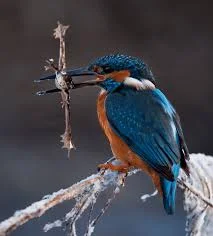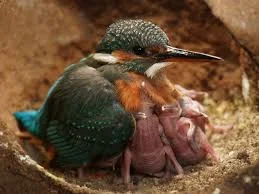Taking care of Common Kingfishers is a wonderful experience. These beautiful birds stand out with their bright blue and orange feathers. If you live near water and want to help them, knowing how to meet their needs is important.
Kingfishers are wild birds best enjoyed in their natural environment, but you can still help them stay healthy and safe by protecting their habitats and supporting conservation. We will share some simple tips to help Common Kingfishers thrive.
Creating the Ideal Habitat for Common Kingfishers
Kingfishers need certain conditions to live and raise their young. They are usually found near clean, calm water like rivers, streams, and ponds. Here’s how you can make their environment better for them.
Keep Water Sources Clean for Common Kingfishers
Kingfishers feed mostly on fish and Aquatic insects, so a healthy environment is important. Avoid tainting nearby water sources and promote clean-up efforts when possible.
Provide Suitable Resting Spots for Common Kingfishers
Kingfishers need firm branches or poles near water to sit on while they search for food. Placing wooden stakes or natural roosts around your water garden can attract them.
Encourage Local Plants
Greenery along the water’s border provides cover and breeding material. Avoid trimming stream edges too neatly, leaving some areas to resemble their natural habitat.
Supporting Common Kingfisher Nesting Habits
Common Kingfishers nest in burrows along sandy or muddy riverbanks. You can support their nesting habits by:
Building Artificial Nesting Banks for Common Kingfishers
If natural riverbanks aren’t available, create man-made nesting banks using soil and sand layers. Ensure these structures are stable and predator-free.
Preserving Existing Nests for Common Kingfishers
Avoid disturbing areas where kingfishers are nesting. Getting too close to their homes can make them stressed, and they might leave their eggs or chicks behind.
Ensuring a Steady Food Supply for Common Kingfishers

- Adding small lakes with local fish: Small fish species like minnows are perfect for kingfishers.
- Supporting eco-friendly fishing: Support responsible fishing methods in shared water sources to ensure enough food for animals.
- Reducing Chemical Use: Chemicals harm aquatic insects, a key food source for kingfishers. Avoid using chemicals near water bodies.
Protecting Kingfishers from Common Threats
Kingfishers face many challenges in nature. By being aware of these threats, you can help them thrive:
- Protect Against Predators: Cats, larger birds, and snakes can harm kingfishers. Keep household pets away from nesting areas.
- Minimize Human Disturbance: Loud noises, heavy people walking, and frequent human activity near their habitat can stress kingfishers. Observe them respectfully from a distance.
- Stop Pollution: Chemicals, plastic, and other waste harm kingfishers’ food sources and habitat. Support local conservation efforts to keep water sources clean.
Observing Common Kingfishers in Nature Respectfully
Watching kingfishers in action is a magical experience, but it’s important to respect their space. Here’s how to enjoy their presence without harming them:
Use Spyglasses or Cameras for Common Kingfishers
Instead of getting too close, use tools like spyglasses or a zoom lens to watch them from a distance.
Maintain Silence for Common Kingfishers
Sudden movements or loud noises can scare kingfishers away. Move near quietly and stay calm to avoid disturbing them.
Avoid Feeding Them
Kingfishers are skilled hunters and don’t require handouts. Feeding them can disturb their natural hunting abilities.
Why Protecting Kingfishers’ Habitat Matters

- Join Nature Organizations: Many groups work to preserve natural habitats for birds like the kingfisher. Helping out with these groups can make a big impact.
- Educate Others: Spread awareness about the importance of preserving water ecosystems for kingfishers and other animals.
- Participate in Clean-Up Efforts: Take part in or organize events around local rivers, ponds, or streams to keep habitats clean and safe.
